This post continues an ongoing blog series highlighting various complete street elements, their benefits, and use in Michigan communities. Check back often to catch future posts, and keep a lookout for mid-block pedestrian crossings in your community!
What are Mid-Block Pedestrian Crossings? Mid-block pedestrian crossings are marked crosswalks placed between intersections. They look similar to intersection crosswalks, but often incorporate several design features to increase safety. Mid-block crossings frequently include pedestrian islands, which provide a safe refuge for pedestrians crossing two-way traffic. Users can check traffic one way, cross to the island, and check traffic in the other direction before continuing to cross. Yield lines can be set back to require vehicles to stop farther away from the intersection. Bulb-outs that narrow the roadway can be used to calm traffic by slowing speeds, and can make pedestrians more visible to drivers. Where traffic volumes are heavy, mid-block crossings can be signalized to further increase safety and comfort.
Why Use Mid-Block Pedestrian Crossings? Many people do not go out of their way to cross at established intersections. Instead, they choose to cross the street using the most direct route, even if that means crossing several lanes of busy traffic. Mid-block pedestrian crossings decrease random and unpredictable crossings associated with a high risk of collisions, especially in areas that are heavily travelled by pedestrians or where block lengths are long.
When to Use Mid-Block Pedestrian Crossings: An engineering study should be completed to determine the need for a mid-block crossing, which incorporates roadway width, traffic volume, traffic speed and type, desired lines for pedestrian movement and adjacent land use. Heavily traveled areas that have high incidences of random crossings are good candidates for mid-block crossings, including schools, shopping centers, transit centers, and college campuses.
The above factors also determine whether bulb-outs, pedestrian islands, and signals should be incorporated into the mid-block crossing design. In general, local roads with low speeds and low traffic volumes are less likely to need these additional elements. As speed limits, number of lanes, and traffic volumes increase, these additional traffic calming and safety elements become increasingly necessary.
Safety Benefits: Mid-block locations account for more than 70% of pedestrian fatalities. Mid-block pedestrian crossings increase safety by decreasing random and unexpected pedestrian crossings. As stated before, people tend to cross where it is most convenient for them to cross, creating a high risk of collisions. Mid-block pedestrian crossings consolidate pedestrian traffic and allow drivers to predict and expect pedestrian traffic. Around 83% of pedestrians surveyed in an East Lansing, MI study changed their crossing behaviors where mid-block crossings were present. Where pedestrian islands have been included in the crosswalk design, pedestrian crashes were reduced by 46% and vehicle crashes were reduced by 39%. Because mid-block crosswalks can be difficult to use for individuals with visual impairments, adding a crosswalk signal to the crossing will help make the treatment safer for all users.
What Drivers Should Know: While mid-block pedestrian crossings help drivers know where pedestrians are most likely to cross, some pedestrians may still choose to cross at random points along the road. Accordingly, drivers should remain alert for pedestrians crossing outside of the crosswalk. Be aware of signage that will signal a mid-block crossing is approaching. When coming up to unsignalized and signalized mid-block crossings, drivers should prepare to yield in anticipation of pedestrians crossing. Where a pedestrian is on a crosswalk or when alerted by signal, a driver must stop behind the yield lines that proceed the crosswalk.
Cost Considerations: Costs for mid-block pedestrian crossings can vary significantly with mid-block characteristics and the need for pedestrian islands, signals, or bulb-outs. Additional treatment costs include Bulb-outs, which can cost between $5,000 and $25,000 per corner, pedestrian islands, which can run between $4,000 and $30,000, and countdown/crosswalk signals, which can cost between $5,000 and $15,000. More Expensive Pedestrian Hybrid Beacons can be included if deemed necessary. Adding these elements during planned construction will help to decrease project costs.
Mid-block pedestrian crossings are common in Michigan. A few examples include: East Lansing, which has a mid-block crosswalk that covers five lanes of traffic, and includes a pedestrian shelter; a short mid-block crossing between Michigan and Allegan along Washington Street’s business district in Lansing; and a crossing outside Frost Elementary School in Jackson.
Have mid-block pedestrian crossings in your community? Let us know.
Check out these resources for more information:
Best Design Practices for Walking and Bicycling in Michigan (Pages 26, 27, 29, and 32)
Crossing Enhancements Commonly Used in Mid-block Crossings
FHWA Course of Mid-block Crossings
MDOT Presentation on Design Ideas to Improve Pedestrian and Bicycle Safety
Mid-block Fact Sheet from Kansas DOT
Next Topic: Road Diets
Previous Topic: Contra-flow Bike Lanes

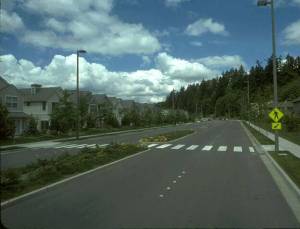
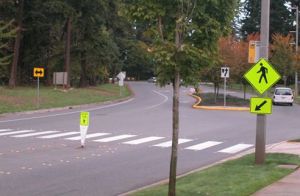
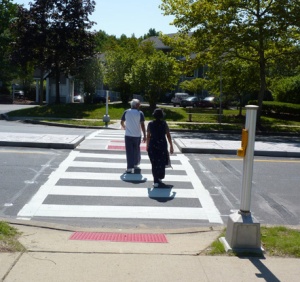
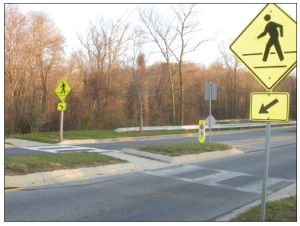


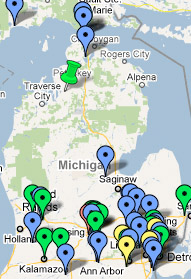
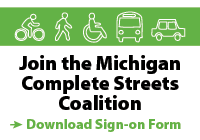











Leave a comment
Comments feed for this article